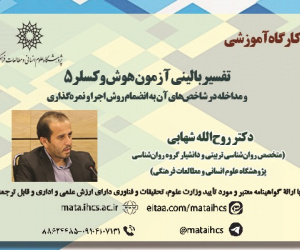آینده پژوهی مهاجرت در استان آذربایجان شرقی با رویکرد سناریونگاری (مقاله علمی وزارت علوم)
درجه علمی: نشریه علمی (وزارت علوم)
آرشیو
چکیده
مهاجرت به عنوان یکی از مهم ترین پدیده های جمعیت شناختی، نقشی تعیین کننده در تحول ساختارهای اجتماعی، اقتصادی و جغرافیایی ایفا می کند. در دهه های اخیر، جابه جایی گسترده جمعیت به دلایل متنوع، از جمله عوامل اقتصادی، زیست محیطی و اجتماعی، به یکی از چالش های اساسی مدیریت جمعیت و برنامه ریزی منطقه ای تبدیل شده است. این چالش ها، نیاز به تحلیل آینده نگرانه و تدوین راهکارهای مؤثر را برای بهبود شرایط و کاهش پیامدهای منفی آشکارتر کرده اند. در همین راستا، پژوهش حاضر با هدف آینده پژوهی مهاجرت در استان آذربایجان شرقی و تدوین سناریوهای عملیاتی جهت مدیریت و برنامه ریزی مطلوب انجام شده است. این تحقیق از نوع کاربردی و توصیفی-تحلیلی بوده و با بهره گیری از رویکرد آینده پژوهی، داده های خود را از طریق روش های اسنادی و پیمایشی گردآوری کرده است. تحلیل این داده ها با استفاده از تکنیک دلفی و ابزارهایی مانند ماتریس اثرات متقاطع و نرم افزار سناریو ویزارد صورت گرفته است. جامعه آماری این پژوهش شامل 20 نفر از کارشناسان برنامه ریزی شهری و منطقه ای استان می باشد. بر اساس نتایج به دست آمده، 42 عامل به عنوان مؤثرترین عوامل مهاجرت استان شناسایی شد. نتایج حاصل از پژوهش بیانگر این است که با استفاده از روش میک مک، ۱۳ عامل کلیدی نظیر نرخ بالای بیکاری، نبود منابع آبی پایدار، کاهش جمعیت روستایی و ضعف شبکه جاده ای به عنوان پیشران های اصلی شناسایی شدند. در ادامه، بر مبنای این پیشران ها، سه سناریوی قوی، ضعیف و باورکردنی برای آینده مهاجرت در استان تدوین گردید. تحلیل نهایی نشان داد که سناریوهای باورکردنی، به دلیل تعادل میان مطلوبیت و قابلیت تحقق، مبنای برنامه ریزی قرار می گیرند. در راستای دستیابی به این سناریوها، شناسایی و تقویت عوامل کلیدی و ارائه راهکارهای مناسب، از جمله توسعه زیرساخت ها و کاهش چالش های اقتصادی، ضروری است.The future studies of migration in East Azerbaijan province with a scenario-based approach
Migration, as one of the most significant demographic phenomena, plays a decisive role in shaping social, economic, and geographical structures. In recent decades, large-scale population movements driven by diverse factors, including economic, environmental, and social causes, have become one of the primary challenges for population management and regional planning. These challenges have heightened the necessity for foresight analysis and the development of effective strategies to mitigate adverse impacts and capitalize on opportunities. This study focuses on migration forecasting in East Azerbaijan Province and aims to develop actionable scenarios for optimal management and planning. The research is applied and descriptive-analytical in nature, employing a futures studies approach. Data were collected through documentary and survey methods and analyzed using Delphi techniques, the Cross-Impact Matrix, and Scenario Wizard software. The statistical population includes 20 experts in urban and regional planning within the province. The findings identify 42 factors influencing migration in the province, among which 13 key drivers were determined using the MICMAC method. These key drivers include high unemployment rates, lack of sustainable water resources, rural depopulation, and inadequate road networks. The study further developed three scenarios- strong, weak, and plausible- to predict the future of migration in the region. The final analysis revealed that plausible scenarios, due to their balance between feasibility and desirability, serve as the basis for planning. Achieving these scenarios requires a thorough understanding of key drivers and the implementation of targeted measures. Recommendations include enhancing infrastructure, addressing economic challenges, and promoting sustainable development to improve migration-related conditions in East Azerbaijan Province. These steps are crucial for aligning planning strategies with future migration trends and ensuring balanced regional development.







